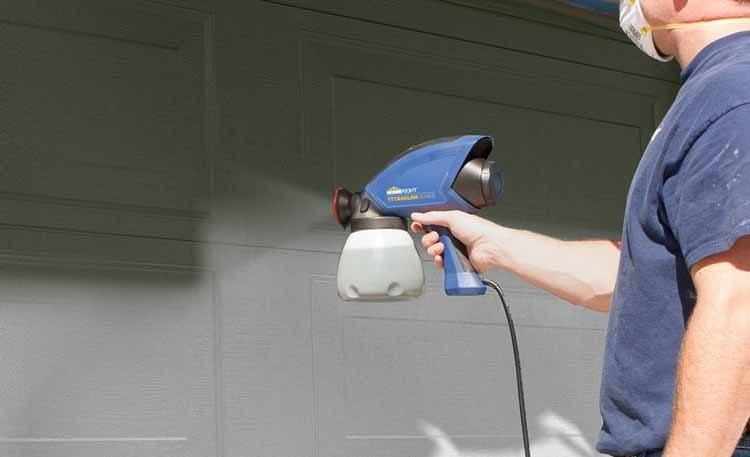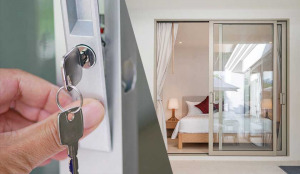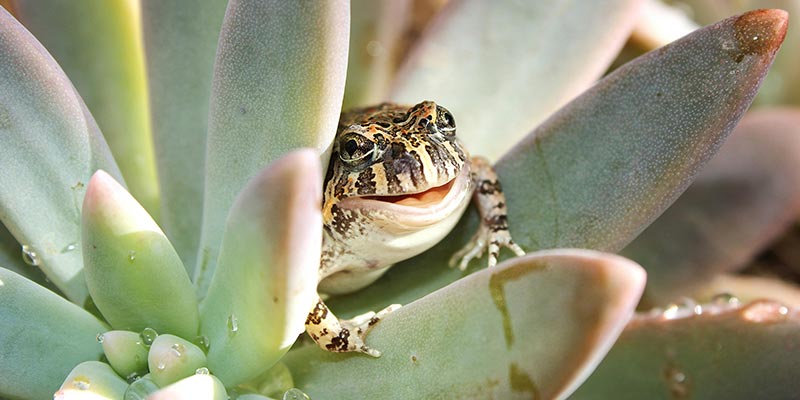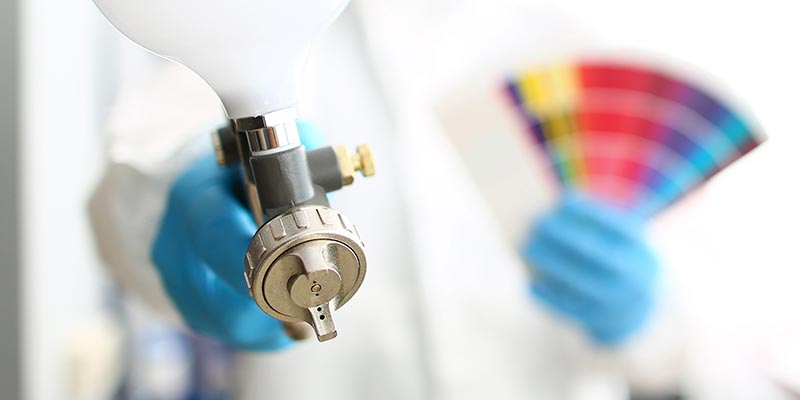Planning to get a paint sprayer for latex paint, but unsure which type you need? In this guide, we explain how to choose the best paint sprayer for latex house paints, including features to look for.
Latex paint is a very common choice for painting interior walls. Latex paint gives you a smooth, beautiful surface, easy cleanup if you have a spill, and fast drying. It is also non-toxic, which means it is better for the environment, especially when compared with oil-based paints.
But if you are planning to primarily use latex paint for your DIY projects, then you need to know what types of sprayers can handle latex paint.
In this article, we explain how to choose the best paint sprayer for latex paint, with a comparison of the different types of sprayers (HVLP vs airless vs compressed air). We’ll also look at features to consider before purchasing a latex paint sprayer, and painting tips specific to latex.

What is a Latex Paint Sprayer?
There is no paint sprayer that is only designed for use with latex paint.
Rather, when we talk about latex paint sprayers, we are referring to paint sprayers of any type that are capable of handling latex paint and produce a good latex paint finish. While paint sprayers are not required for applying latex paint, they do offer some advantages over using a roller and brush.
For home DIY painters, paint sprayers are designed to provide fast and easy application of paint, and most can handle a great variety of paints as well as other fluids such as stain and varnish. Paint sprayers allow you to quickly apply new coats of paint to large surfaces and get to hard-to-reach nooks and crannies, which are very pain-staking and time-consuming to do with a roller and brush.
However, not all paint sprayers are made equal, and some are better suited to painting walls and large surfaces with latex paints than others.
For house painting, there are three different types of paint sprayers:
- Airless
- Compressed Air
- High Volume Low Pressure (HVLP)
Technically, all three can be used for applying latex paint, but depending on your needs, one may be more suitable for you, as we discuss below.

What Type is the Best Paint Sprayer for Latex Paint?
The primary types of sprayers used for household painting are compressed air sprayers, airless paint sprayers and HVLP sprayers. All of these sprayers work with latex paint. However, some types of sprayers are better at painting large surfaces with latex than others.
Best Paint Sprayer for Latex – Comparison Table
| Sprayer Type | Pros | Cons |
|---|---|---|
| HVLP | Beginner-friendly Good Control Lightweight | Overspray Slow with Latex Paint Not Suited to Entire House |
| Airless | High Quality Finish Powerful Long Lifetime Little Overspray Suitable for Large Projects | Takes Time to Learn Messy to Clean Most Expensive |
| Compressed Air | Most Affordable | Least Efficient Poor Quality Finish Requires Air Compressor |
HVLP Sprayers
Best Application: Small Projects, including small interior walls, furniture and cabinets.
HVLP sprayers are great for small-scale interior house painting, and coating small to medium-sized pieces of furniture. Beginners and veteran painters alike find HVLP sprayers to be very helpful. They feature a decent amount of power, although that can also lead to them producing overspray.
HVLP sprayers can be used for latex paint, but they aren’t the best choice for it.
Because of the way latex is manufactured, it can make the flow speed slower. When latex paint is manufactured, the pigment and resins are more coarsely ground compared with other paints, leading to a thicker paint overall. Pushing thick latex paint through an HVLP paint sprayer not designed for it can thereby lead to clogging issues, and a slower painting experience. This is why latex paint is better applied by a brush, roller, or an airless sprayer.
HVLP sprayers offers lighter-weight options when compared to other air sprayers. Small handheld HVLP sprayers are self-contained units making them easier to use and setup, as there is no need for paint hoses or air compressors. This sprayer style allows for variable spray patterns, that can range from one inch to ten inches, giving you a good amount of control over your paint area.
Compared with airless sprayers, they are easier and quicker to cleanup, generally cheaper, and very easy to learn and use. We consider HVLP sprayers to be the second-best paint sprayer for latex house painting, after airless sprayers. If you are looking for an easy device for small interior house painting tasks, it’s a great choice, but they’re not particularly good for large-scale projects.
To learn more, check out our deep dive article on handheld HVLP paint sprayers here.
Airless Sprayers – Best for Latex
Best Application: Large Projects, including house exterior and interior, fences and decks.
Of all the options, we consider airless sprayers to be the best paint sprayer for latex paint. The main reason is because of their excellent finish quality and suitability to large-scale house painting projects, which is the most likely project on which you would use latex paint.
Airless sprayers are the most powerful option and they are ideally suited for painting outside. In saying that, they also work well for painting interior walls and other tall and wide surfaces with any paint, including latex house paint.
Airless paint sprayers offer a controlled diameter, dense spraying and the highest quality finish. An airless paint sprayer eliminates the need to thin the paint, which can save you time and work. These sprayers tend to have less problems with over-spraying, as well.
Now, airless sprayers may sound perfect, but there are some downsides to draw attention to.
While airless sprayers are not difficult to operate, they do have a bit of a learning curve. Cleaning them up can be kind of a hassle, and you could end up leaving a big mess if you’re not familiar with using them or you’re just starting out.
They can seem expensive, when compared with handheld HVLPs. Airless sprayers are well worth the investment, however, if you want a quality device for the long-haul and you’re willing to put the time and effort into learning to setup and use it correctly.
In our article on the best airless paint sprayers, we found the Graco Magnum X5 to be the best airless paint sprayer for house painting. It’s a very powerful sprayer but not too large for home DIY tasks (unlike Fuji which are over-the-top for home use). It’s also got a good price point of around $400.
Official Product Listing ↗
Read the full product technical specifications on the official Graco product web page for the Magnum X5.
Compressed Air Sprayers
Compressed air sprayers are typically the most affordable option. They produce less of a mess when you’re using them, but that comes at a cost. In terms of performance and efficiency, they are arguably the worst of the options available. For the cheaper price you also sacrifice quality. As the name implies, you also need an air compressor in order for these sprayers to work, which certainly increases the cost if you don’t already own one.
For house painting tasks, we’d advise that you steer clear of compressed air sprayers unless you already own one and know how to use it. If that’s the case, then yes, it can handle latex paint – just don’t expect the same high-quality finish you would get with an airless or HVLP sprayer.
Look for These Features
When deciding on the best latex paint sprayer for your house painting project, look for these features and specifications.
Nozzle/Tip Size
Nozzle/Tip Size: 0.3-0.4mm (0.013-0.017in)
The tip size you choose depends on the viscosity of the paint you are using in the sprayer: thick fluids use large tips, while thin fluids use small tips. Most good quality spray guns come with a variety of tips that can be used with different types of paint. Latex paint is considered a thick paint.
Since we’re talking about latex paint sprayers, the tips have to fall within a certain size range, which is on the larger side. According to This Old House, tips that are somewhere around .013-inch to .017-inch (0.3-0.4mm) will work best for you. That’s actually a decent amount of leeway and you should be able to find sprayers that come with tips in that size range.
Hose Length
Hose Length: 25 feet for outdoors (less for indoors)
From my experience with working with different types of paint sprayers, I’ve found that the general rule with hose length is: the longer, the better. I understand the concern some people might have about the hoses getting in the way, but that’s something proper positioning can fix in a hurry.
Hose length is not that important if all you’re doing is painting stuff inside your workshop, but if you’re going outdoors, this should be of greater importance to you. A hose that is at least 25-feet long is needed if you intend to work outdoors.
Spray Patterns
Spray Patterns: Minimum 3 spray patterns (horizontal, vertical, round/circular)
Painting pieces of furniture and hard to reach places like inside wardrobes can be difficult if the paint sprayer you are using only features one spray pattern. Having the ability to switch to a different spray pattern to ergonomically and neatly reach awkward areas is essential. Fortunately, almost all paint sprayers even the cheapest of the cheap include at least three spray patterns.
Look for a paint sprayer that accommodates these three patterns: horizontal, vertical, round/circular. Any extra patterns above that is a bonus. Check the controls and make sure that it is easy to reach and switch between the spray patterns, as that will allow you to quickly flick between them while painting and moving around your project.
Adjustable Flow Rate
Flow Rate: Ensure adjustable flow rate is an option
In a paint sprayer, power and flow rate are closely related. Flow rate refers to the pressure and speed that the paint comes out of the sprayer. The amount of power you’ll need in your sprayer will vary depending on the work you are doing.
The greater the flow rate, the greater the pressure, and as a result more paint exits the sprayer, resulting in a dense coat and faster application. This is ideal in situations where you need to cover broad areas quickly, such as walls or decks. On the other hand, a lower flow rate means less pressure, therefore a lighter coat. This is better for applications where more control, precision and attention to detail is needed, such as painting furnishings.
As you can see, being able to control the flow rate is important. The good news is that most paint sprayers are equipped with dials that allow you to adjust how powerful the stream of paint coming out of it is (that is, the flow rate or flow speed). Ensure you choose a model with this feature.
FAQs
Do you need thin latex paint for an airless sprayer?
You do not need to thin latex paint for airless sprayers. They way in which they are designed means that thinning paint is not a requirement, unlike compressed air guns. Some HVLP sprayers need a thinned solution as well. In this regard, airless sprayers are convenient and save a few ticks on the clock.
How long does it take for latex paint to dry?
Give or take, latex paint dries within an hour. If you are wanting to do another coat, let the first one rest for about four hours. It takes around two weeks for the paint to fully set after all the coats are applied. Done right, latex can give a beautiful finish.
Can you use latex paint in a gravity feed spray gun?
This is possible, though it would require certain sized tips. A size 2.0 or above would work well. Smaller tips on this sprayer tend to clog easily with latex paint. Gravity-feed sprayers offer a narrower stream than others, which is wonderful for precision painting.
Conclusion
We hope you’ve found this article useful, and are now well on your way to finding your ideal paint sprayer for latex house paints.
To recap, we consider an Airless paint sprayer to be the best latex paint sprayer type, as it is suited to large-scale house painting projects and gives a high quality finish. They cost a little bit more and take more time and effort to learn, but are worth it in the long-run.
Interested in learning more? Understand the difference between enamel paint vs latex paint in our quick read here and learn how to clean dried latex paint from a paint sprayer here. You may also find it helpful to know how to get rid of the paint smell and fumes from your house, in preparation for your latex house painting project.
Happy painting!
This article was originally written in December 2018, revised in October 2022, and updated in June 2023.
Author

A jack of all trades, Todd has been a DIY enthusiast, traveler, and writer for many years. He has a deep understanding of all types of painting tools and door hardware, and has shared many articles on these topics throughout the years.
View all posts










